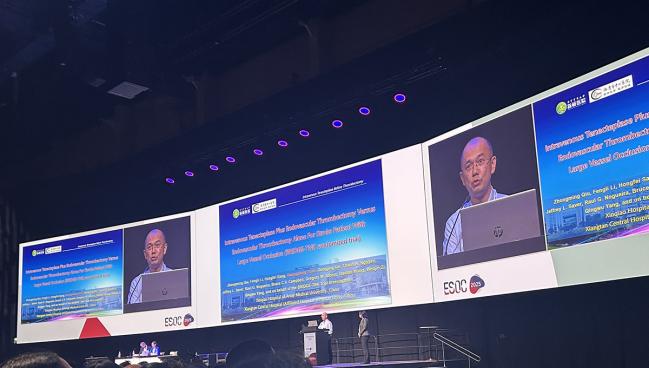IV Tenecteplase Helps Before Stroke Thrombectomy: BRIDGE-TNK
Findings from the Chinese randomized trial support what most centers in the US are already doing, one expert says.

HELSINKI, Finland—Patients with acute ischemic stroke caused by a large-vessel occlusion (LVO) who are undergoing endovascular thrombectomy fare better when intravenous tenecteplase (TNK) is administered beforehand, according to results from the randomized BRIDGE-TNK trial.
At 90 days, the rate of functional independence was 52.9% in patients who received tenecteplase and 44.1% in those who did not receive IV thrombolysis before the procedure (adjusted risk ratio 1.18; 95% CI 1.01-1.39), Guangxiong Yuan, MD (Xiangtan Central Hospital, China), reported here at the European Stroke Organisation Conference (ESOC) 2025.
However, “the lack of a consistent significant benefit across secondary outcomes makes this finding tenuous,” the researchers note in a simultaneous publication in the New England Journal of Medicine.
Safety was similar in both groups, Yuan reported.
Even so, Pooja Khatri, MD (Yale School of Medicine, New Haven, CT), who was not involved in the study, said it “reinforces what we’ve generally been expecting, which is that we are better off giving TNK than not giving TNK when we do endovascular therapy.”
This type of trial probably would not have been done in the United States because IV thrombolysis has become standard of care in most centers, she pointed out.
Based on prior studies that didn’t show much of a difference between administering or not administering IV thrombolysis before thrombectomy, “there were times where I was on the fence about the risk” of using it, Khatri said. After seeing the BRIDGE-TNK results, “maybe I’m going to be a little more hesitant to skip it,” she said.
The BRIDGE-TNK Trial
The rationale for IV thrombolysis before mechanical thrombectomy is that it could enhance perfusion, albeit with a possible increase in bleeding. Several trials have examined the impact of IV thrombolysis before thrombectomy in patients presenting within 4.5 hours of stroke onset, including DEVT, SKIP, MR CLEAN-NO IV, DIRECT-MT, SWIFT-DIRECT, and DIRECT-SAFE. A pooled analysis of these studies showed no significant difference in outcomes between patients who did versus did not receive IV thrombolysis.
Only 2.2% of patients in those trials received tenecteplase instead of alteplase, however. Tenecteplase, a genetically modified tissue plasminogen activator, has some advantages over its cousin, including a longer half-life (allowing for administration as a bolus rather than a 1-hour infusion) and greater fibrin specificity. But there had not been a trial comparing IV tenecteplase plus thrombectomy with thrombectomy alone, Yuan said.
BRIDGE-TNK, conducted at 39 thrombectomy-capable stroke centers in China, was an open-label trial of 550 patients (median age 70 years; 42% women) with acute ischemic stroke caused by an LVO. All patients presented within 4.5 hours of when they were last known to be well, were scheduled for thrombectomy, and were eligible to receive IV tenecteplase.
About 60% of strokes were cardioembolic, with another 30% attributed to large-artery atherosclerosis. At baseline, median NIHSS score was 16 and median ASPECTS was 8.
In the patients randomized to receive IV tenecteplase, the drug was given as a bolus dose of 0.25 mg/kg (maximum dose 25 mg) and followed by a saline flush. The thrombectomy approach used in both arms of the trial was left to the discretion of the operator. The procedure involved angioplasty/stenting in 19.5% of the IV tenecteplase arm and 27.5% of the control arm.
The median time from the start of IV tenecteplase to thrombectomy was 16 minutes. The median time from thrombectomy puncture to reperfusion was shorter in the patients who did versus did not receive thrombolysis (55 vs 64 minutes), and that may have played a role in the improved outcomes seen in the treated patients, the researchers say.
Functional independence was defined by a modified Rankin Scale (mRS) score of 0-2 at 90 days, and although this was more likely in patients who received IV tenecteplase, the overall distribution of mRS scores was no different between groups (adjusted generalized OR 1.16; 95% CI 0.94-1.43).
Several secondary outcomes, including quality of life according to the EQ-5D-5L questionnaire, did not differ either. Successful reperfusion before thrombectomy, however, was significantly more likely in the patients who received IV thrombolysis (6.1% vs 1.1%).
In terms of safety, the two groups had similar rates of symptomatic intracranial hemorrhage within 48 hours (8.5% in the tenecteplase group vs 6.7% in the control group; P = 0.33) and death within 90 days (22.3% vs 19.9%; P = 0.39).
Yang noted that his team is in the planning stages of another trial, called BRIDGE-TNK EXTEND, that will explore the impact of IV tenecteplase prior to thrombectomy in patients presenting between 4.5 and 24 hours after stroke onset, with enrollment scheduled to begin later this year.
Todd Neale is the Associate News Editor for TCTMD and a Senior Medical Journalist. He got his start in journalism at …
Read Full BioSources
Qiu Z, Li F, Sang H, et al. Intravenous tenecteplase before thrombectomy in stroke. N Engl J Med. 2025;Epub ahead of print.
Disclosures
- BRIDGE-TNK was supported by the Chongqing Science and Health Joint Medical Research Project, the National Natural Science Foundation of China, the Second Affiliated Hospital of Army Medical University, and China Shijiazhuang Pharmaceutical Company Recomgen Pharmaceutical (Guangzhou), which provided tenecteplase.
- Yang reports no relevant conflicts of interest.





Comments